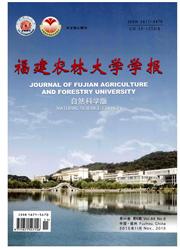

 中文摘要:
中文摘要:
以1年生台湾桤木幼苗为材料,采用土培方法,培养3个月后对其进行NaCl胁迫试验,幼苗经过不同含量NaCl(0、0.1%、0.2%、0-4%、0.6%)胁迫30和60d后,研究幼苗叶片生理特性的变化规律.结果表明,随着NaCl含量的增加和处理时间的延长,台湾桤木幼苗叶片叶绿素含量及类胡萝卜素含量逐渐降低,丙二醛含量呈上升趋势,但0.4%和0.6%NaCl胁迫30d后,台湾桤木幼苗相继枯死.NaCl胁迫30d后,幼苗叶片脯氨酸含量随着NaCl含量升高表现出先下降再上升的趋势;在低含量NaCl(0.1%和0.2%)胁迫60d后,脯氨酸含量随着胁迫时间的延长不断增加.幼苗叶片内的SOD活性随NaCl含量的增加而逐渐提高,但其活性随处理时间的延长有所下降.因此,台湾桤木幼苗对低含量的盐具有一定的耐受性.
 英文摘要:
英文摘要:
Annual Alnus formosana seedlings were planted in soil culture for 3 months. Under different concentrations (0, 0.1%, 0.2%, 0.4%, 0.6% ) of salt stress, the change of leaf physiological characteristics of Alnusformosana seedling was investigated in 30 days and 60 days. The results showed that under salt stress the leaf chlorophyll content and carotenoid content in Alnusformosana seedling gradually decreased, but the amount of malondialdehyde showed an increasing tendency with the extension of concentration and time. Alnus formosana seedlings under the concentrations (0.4% , 0.6% ) of salt stress died off 30 days later. After 30 days salt stress, the proline content in seedling leaf decreased at first and then increased with increasing concentration of salt. Under the concentrations (0.1%, 0.2% ) of salt stress, the prollne content increased with the extension of time after 60 days. The superoxide dismutase activity in seedling leaf gradually increased with the extension of concentration, but it decreased with the extension of pro- cessing time. In conclusion, these results suggested that Alnus formosana seedlings had a certain tolerance to lower salt stress.
 同期刊论文项目
同期刊论文项目
 同项目期刊论文
同项目期刊论文
 期刊信息
期刊信息
